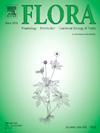生殖相关性状对破碎化景观中湿草甸物种生存的意义
IF 1.8
4区 生物学
Q3 ECOLOGY
引用次数: 0
摘要
生境破碎化是指连续的生境破碎成多个孤立的斑块,这可能导致植物物种的种群减少。个别物种对破碎化的反应在很大程度上取决于特定的植物生殖性状,包括与授粉有关的性状。为了揭示这些植物性状在破碎景观中对植物生存的作用,我们以欧洲草原为目标,这是世界上最破碎的生物群落。我们探讨了湿润草甸的植物是否受到斑块之间连通性的影响,如果是这样,哪些生殖性状对它们的成功负责。具体而言,我们构建了39个湿草甸物种的性状套件,包括15个与繁殖和授粉相关的性状。6个性状是重要的预测因子,其重要性由高到低依次为:花期、花的颜色、花的可获得性、无性系、花蜜指南的存在和植物对特定数量的传粉者功能群的专门化。被发现的更成功的物种的主要特征是开花持续时间更长,呈现出特定的花色(如紫外光-黄色明亮),容易获得奖励,高度无性系,没有花蜜向导,被许多传粉者群体访问。我们的研究结果显示,最成功的物种呈现出更广泛的生态位。我们强调了检查研究较少的花性状以及相关生态过程的重要性,以更好地了解驱动物种在碎片化栖息地中成功的因素。本文章由计算机程序翻译,如有差异,请以英文原文为准。
The significance of reproduction-related traits for wet meadow species survival in a fragmented landscape
Habitat fragmentation refers to the breaking of continuous habitats into multiple isolated patches, which can result in smaller populations of plant species. The response of individual species to fragmentation can be largely determined by specific plant reproductive traits including traits related to pollination. To reveal the role of these plant traits for plant survival in fragmented landscapes, we targeted European grasslands, the most fragmented biome in the world. We explored whether plants of wet meadows are affected by the degree of connectivity between patches and, if so, which reproductive traits are responsible for their success. More particularly, we constructed a trait suite for 39 wet meadow species encompassing 15 traits related to reproduction and pollination. Six traits were revealed as important predictors, which in decreasing order of importance were: flowering duration, floral colour, flower’s reward accessibility, clonality, nectar guides presence, and plant’s specialisation to particular number of pollinator functional groups. Species found to be more successful were characterised mainly by increased flowering durations, displayed certain floral colours (e.g. UV - yellow bright), had easily accessible rewards, were highly clonal, did not hold nectar guides and were visited by many pollinator groups. Our results revealed that the most successful species presented altogether broader ecological niches. We highlight the importance of examining poorly studied floral traits alongside related ecological processes to understand better the factors driving species' success in fragmented habitats.
求助全文
通过发布文献求助,成功后即可免费获取论文全文。
去求助
来源期刊

Flora
生物-植物科学
CiteScore
3.30
自引率
10.50%
发文量
130
审稿时长
54 days
期刊介绍:
FLORA publishes original contributions and review articles on plant structure (morphology and anatomy), plant distribution (incl. phylogeography) and plant functional ecology (ecophysiology, population ecology and population genetics, organismic interactions, community ecology, ecosystem ecology). Manuscripts (both original and review articles) on a single topic can be compiled in Special Issues, for which suggestions are welcome.
FLORA, the scientific botanical journal with the longest uninterrupted publication sequence (since 1818), considers manuscripts in the above areas which appeal a broad scientific and international readership. Manuscripts focused on floristics and vegetation science will only be considered if they exceed the pure descriptive approach and have relevance for interpreting plant morphology, distribution or ecology. Manuscripts whose content is restricted to purely systematic and nomenclature matters, to geobotanical aspects of only local interest, to pure applications in agri-, horti- or silviculture and pharmacology, and experimental studies dealing exclusively with investigations at the cellular and subcellular level will not be accepted. Manuscripts dealing with comparative and evolutionary aspects of morphology, anatomy and development are welcome.
 求助内容:
求助内容: 应助结果提醒方式:
应助结果提醒方式:


